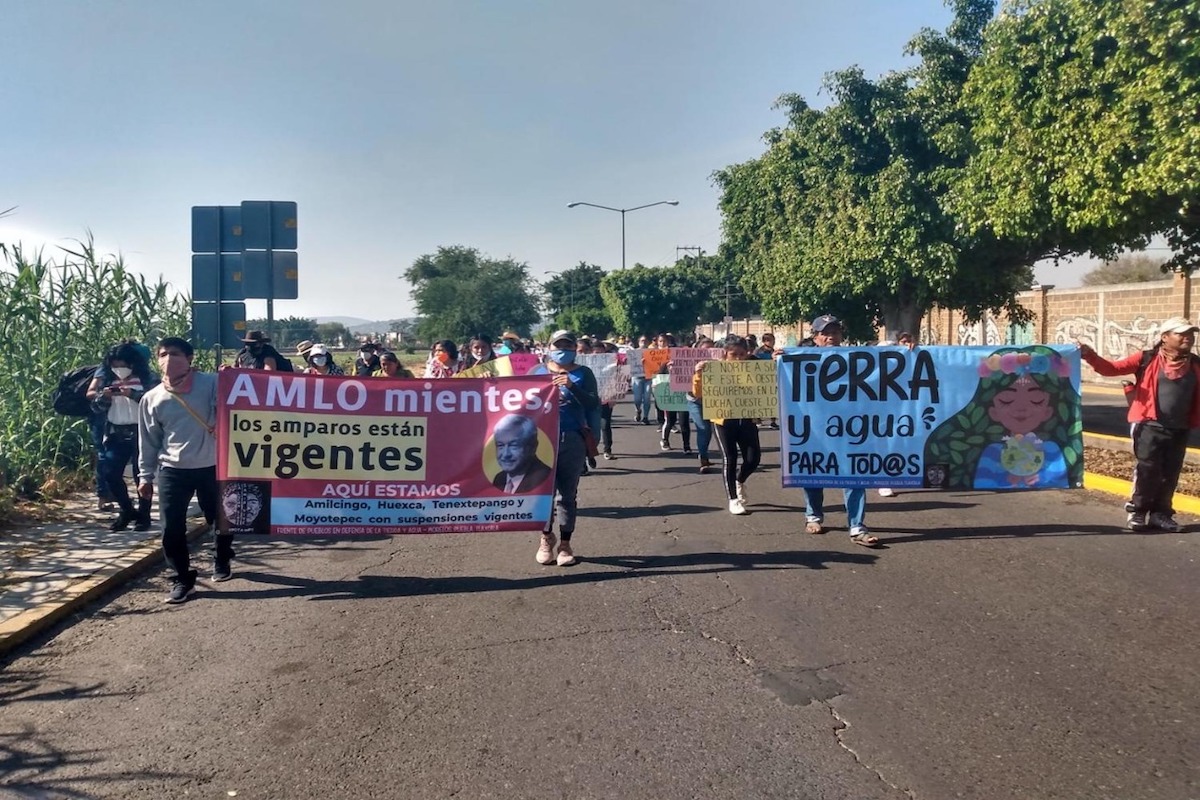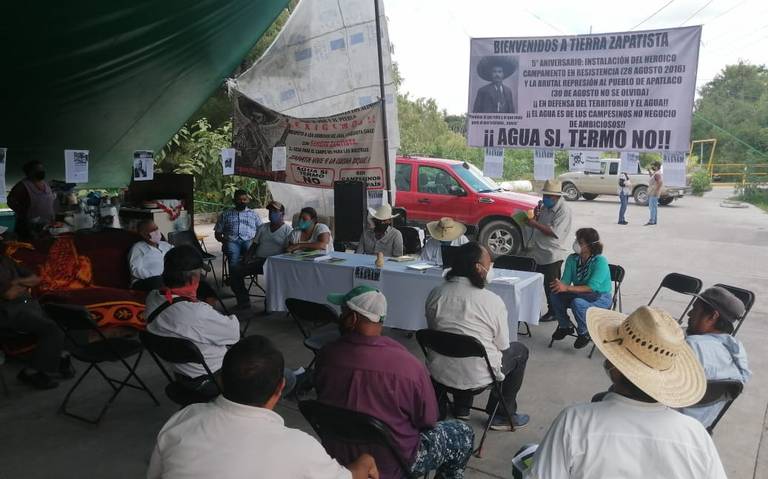

Protesters march in November 2020 following the National Guard’s eviction of the Apatlaco plantón. (Photo from the Frente de Pueblos en Defensa de la Tierra y el Agua de Morelos, Puebla y Tlaxcala)
MEXICO CITY — Operations at the newly constructed thermoelectric plant in Huexca, Morelos could begin in the near future, despite yearslong delays caused by vocal opposition and unresolved legal issues.
Local communities have resisted the plant that would generate electricity as part of the larger Proyecto Integral Morelos (Morelos Integral Project), along with a gas pipeline and aqueduct, on the basis of several grievances, including potential environmental impacts on the water used by local communities, as well as the government’s lack of transparency surrounding the projects.
Huexca is about two hours south of Mexico City by car.
“For ten years we have been fighting and asking for justice,” said Antonia Nava Martínez, a protestor from the village of Moyotepec. “We have only received repression, imposition and name-calling; insults for defending our human and collective rights, wanting to eradicate our collective identity.”
As workers have continued to conduct tests at the plant worth 22 billion pesos (over $1 billion), grassroots resistors forming the Frente de Pueblos en Defensa de la Tierra y el Agua de Morelos, Puebla y Tlaxcala (Peoples’ Front in Defense of the Land and Earth of Morelos, Puebla and Tlaxcala) have protested outside of the facility since December.
To cool the turbines at the plant, the adjoining aqueduct must draw 50 million liters of water daily from the Cuautla River, despite a statement by the state-owned electricity utility Comisión Federal de Electricidad (Federal Electricity Commission) that said that the plant would only draw from only treated sewage. The river sustains 32 ejidos, or communal agriculture lands. Many of the ejidatarios —who collectively regulate use of increasingly scarce water supplies for irrigation through the Asociación de Usuarios del Río Cuautla (Cuautla River Users Association)— warn that the project will deplete remaining supplies and return to the river contaminated water.
“Climate change, overexploitation and earthquakes have decreased the flow of the river. Since the times of the conquest, it is our native pueblos who are using the river water,” said Nava Martínez, who has been an ejidataria of ASURCO for over 25 years. “We have no other way of living… without water, as more poor and contaminated, we will only have death.”


Protesters in opposition to the Proyecto Integral Morelos sit at the plantón, or protest site, in Apatlaco, Morelos before it was vacated by the National Guard in November 2020. (Photo from the Frente de Pueblos en Defensa de la Tierra y el Agua de Morelos, Puebla y Tlaxcala)”
Although the government approved the Manifestación de Impacto Ambiental (Environmental Impact Statement) necessary for the thermoelectric plant to be constructed, that assessment took into account neither the aqueduct’s full impacts on the Cuautla River nor ASURCO members’ water rights, said Juan Carlos Flores Solís, a lawyer representing the FPDTA-MPT.
In a March 2 press conference, Flores Solís said that the aqueduct’s construction and operation are illegal because the CFE lacks the required permits, including one to “change the use of water from agricultural to industrial.” Though the president of ASURCO, Rogelio Plascencia, supposedly signed an agreement with CFE and other relevant parties to divert water to the thermoelectric plant, ASURCO members were not consulted in full before the signing.
“Operations at the thermoelectric plant have not been able to start because of technical problems and also because the amparos continue to be valid,” Flores Solís said. He stated that against various parts of the Proyecto Integral Morelos, there are currently 20 active amparos, which are extraordinary constitutional appeals filed in federal courts that, among other purposes, serve to protect the rights of ejidatarios.
The government has continued to not acknowledge the amparos and the requested suspensions of project activities, with President Andrés Manuel López Obrador claiming last year that they were all “resolved.” In recent months, the FPDTA-MPT has resorted to other legal remedies, including filing “incidents of violations of suspensions” with federal courts and a complaint with the Inter-American Commission on Human Rights. Last November 30, the IACHR demanded that the federal government provide it with further information on the project status and respect the amparo-related suspensions.
Members of the FPDTA-MPT believe that the thermoelectric plant merely previews more industrialization projects to be constructed in Morelos down the line like industrial parks—all of which would require additional water supplies. “The thermoelectric is the heart of everything that could come,” said Jorge Velázquez, a member of FPDTA-MPT and a native of Amilcingo, an indigenous Nahua community located seven kilometers from the plant.


Protesters stage a demonstration in Cuernavaca on the second anniversary of the death of Samir Flores Soberanes, a Nahua activist from Amilcingo who was murdered in 2019 for his work opposing the project. (Photo from the Frente de Pueblos en Defensa de la Tierra y el Agua de Morelos, Puebla y Tlaxcala)
The CFE maintains that the thermoelectric plant is necessary since it would meet 80% of energy demand in Morelos. The objective coheres with López Obrador’s pursuit of greater energy self-sufficiency for Mexico during his sexenio. He has begun to achieve this in part by bolstering state-owned companies like the CFE and the petroleum monopoly Petróleos Mexicanos through protectionist policies, which critics argue also discourage investments in clean energy.
When López Obrador toured communities in Morelos during his 2018 presidential campaign, he told local residents, “that the thermoelectric would not pass and we believed in him,” said Velázquez. “And now, look at what happened. We don’t believe in him, in the system or in any authorities.”
***
Jacob Alabab-Moser is a Mexico City-based freelance journalist. Twitter: @JAlababMoser.



[…] Alabab-Moser reports in Latino Rebels: “Operations at the newly constructed thermoelectric plant in Huexca, Morelos […]
[…] Rebels recently reported that the newly constructed thermoelectric plant in Huexca, Morelos could soon begin operations. […]
[…] Peoples’ Front has argued that the aqueduct – that will take 50 million litres of water a day from the Cuautla River to plant to cool its turbines – is illegal because CONAGUA has not granted […]
[…] Peoples’ Front has argued that the aqueduct – that will take 50 million litres of water a day from the Cuautla River to plant to cool its turbines – is illegal because CONAGUA has not granted […]
[…] Rebels has reported: “To cool the turbines at the plant, the adjoining aqueduct must draw 50 million liters of water […]
[…] reported: “To cool the turbines at the [thermoelectric] plant, the adjoining aqueduct must draw 50 million liters of water daily from the Cuautla […]
[…] Latino Rebels has reported: “To cool the turbines at the plant, the adjoining aqueduct must draw 50 million liters of water […]